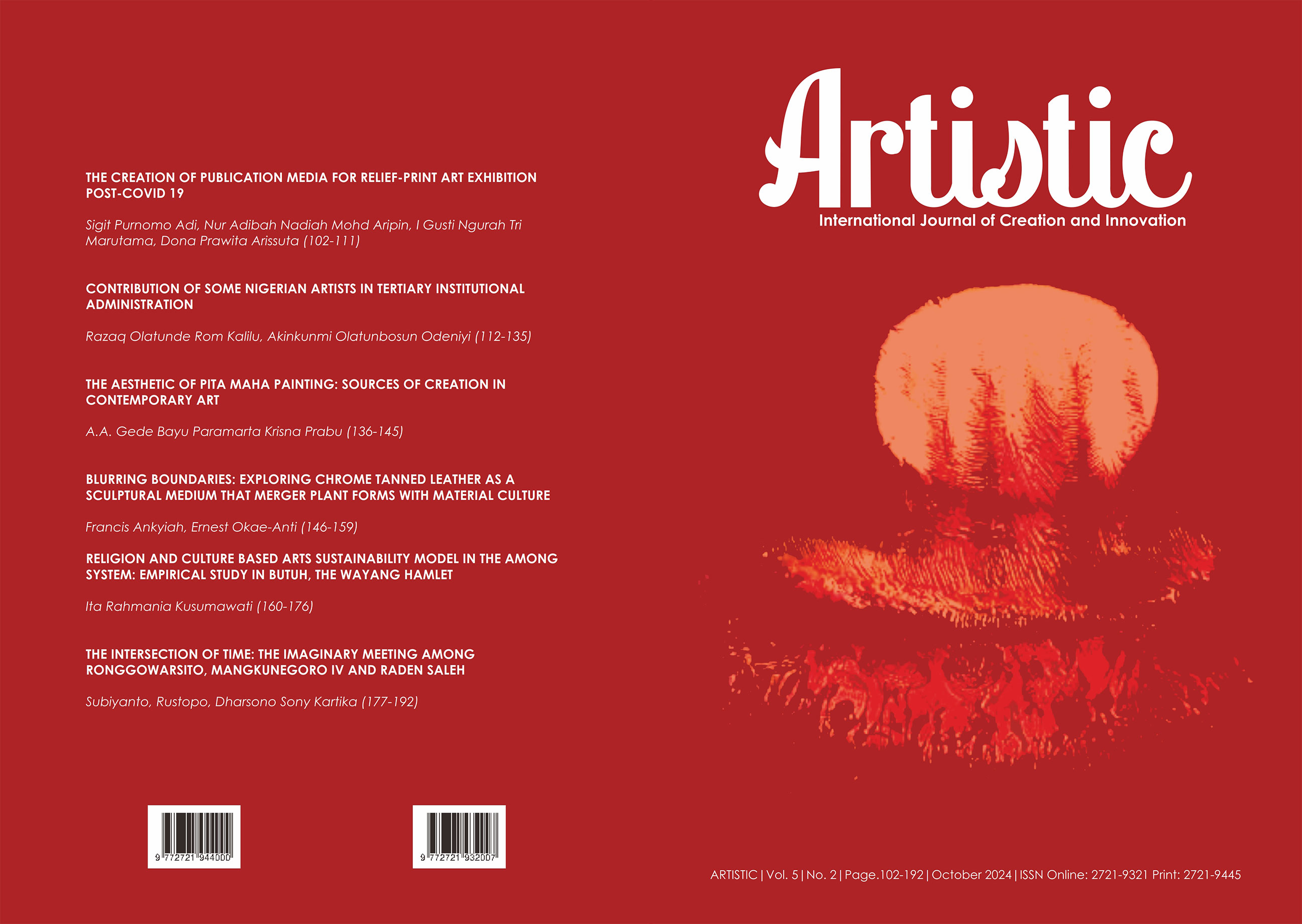CONTRIBUTION OF SOME NIGERIAN ARTISTS IN TERTIARY INSTITUTIONAL ADMINISTRATION
DOI:
https://doi.org/10.33153/artistic.v5i2.5675Keywords:
artists, academics, administrators, Nigerian universitiesAbstract
Modern Nigerian Art emerged as a result of the efforts of artists. The later generation artists, particularly those with significant contributions to visual arts departments in Nigerian Universities deserve adequate scholastic attention. This study is a biographical examination of selected Nigerian artists who function in professional, academic, and administrative capacities in visual art departments in Nigerian universities. Eleven academics who are pioneers, administrators, and sustainers of visual arts departments in Nigerian universities were selected for biographical study based on set criteria. Findings revealed that these academics are material to the establishment, development, and sustenance of their visual art departments and Nigerian visual arts, as heads of department, deans of faculty, heads of university, visiting lecturers, lecturers on sabbatical leave, external examiners, academic assessors, resource persons in programme audit and accreditation exercise, and consultants on the establishment of visual art departments.
Downloads
References
Abubakar, A. R. (2017). Directory of Full Professors in the Nigerian University System (Draft). National Universities Commission.
Adepegba, C. O. (1989). Nigerian Art: the dearth of traditions and the birth of new forms. Kurio African, Journal of Art and Criticism, 1(1), 2–14.
Chukueggu, C. C. (2010). Modern artistic tendency in Nigeria: its influence on the creative development. Kamla-Raj Anthropologist, 12(1), 167–173.
Dike, P. C., & Oyelola, P. (2004). The Zaria Art Society: A new consciousness. National Gallery of Art.
Egonwa, O. D. (2011). Nigerian Art: Introductory Notes. Ababa Press Ltd.
Fafunwa, A. B. (1974). History of Education in Nigeria. George Allen and Unwin.
Filani, E. O. (1998). Form and content as a basis for the classification of contemporary Nigerian art. USO: Nigerian Journal of Art, 1(2), 33–44.
Ganagana, W. S. (2014). Ozidi Avenges: A Sculpto-Graphotherapeutic and Pictorial Naratology in Art. Niger Delta University.
Ikpakronyi, S. O. (2005). Olu Amoda in the development of metal sculpture in Nigeria. USO: Nigerian Journal of Art, 4(1), 71–83.
Irivwieri, G. O. (2010). An appreciation of the state of visual arts in Nigeria 1950-1970. Anthropologist, 12(2), 113–117.
Kalilu, R. O. R., & Akintonde, M. A. (2013). Public sculpture artists in southwestern Nigeria. British Journal of Arts and Social Sciences, 15(2), 143–161.
Mount, M. W. (1973). African Art: The Years since 1920. Indiana University Press.
Okeke, U. (2005). Eke Okaybulu 1916-1958, Painter and Illustrator. USO: Nigerian Journal of Art, 4(1), 54–57.
Okonkwo, I. E., & Akhogba, A. E. (2013). Uche Okeke as a precursor of contemporary Nigerian art education. AFRREV IJAH: International Journal of Arts and Humanities, 2(3), 53–67.
Oloidi, O. (1989). Hindrances to the implantation of modern Nigerian Art in the Colonial Period. Kurio African, Journal of Art and Criticism, 1(1), 15–24.
Oloidi, O. (1998). Onabolu, Pioneer of modern art in Nigeria: An Introduction. USO: Nigerian Journal of Art, 2(1), 1–9.
Oloidi, O. (2008). Philosophical and ideological triumvirate: Schools, Discourse, and Styles in Modern Nigerian Art. In Styles, Schools and Movements in Modern Nigerian Art. National Gallery of Art.
Ubani, K. (2005). Art and Function in the works of Yusuf Adebayo Grillo. USO: Nigerian Journal of Art, 4(2), 58–63.
Wikipedia. (2021). Peju Layiwola. In Wikipedia. https://en.wikipedia.org/wiki/Peju_Layiwola
Downloads
Published
How to Cite
Issue
Section
License
Copyright (c) 2024 Razaq Olatunde Rom Kalilu, Akinkunmi Olatunbosun Odeniyi

This work is licensed under a Creative Commons Attribution-NonCommercial-ShareAlike 4.0 International License.
Copyright
Authors who publish with Artistic agree to the following terms:
- Authors retain copyright and grant the journal right of first publication with the work simultaneously licensed under a Creative Commons Attribution License (CC BY-SA 4.0) that allows others to share the work with an acknowledgment of the work's authorship and initial publication in this journal.
- Authors are able to enter into separate, additional contractual arrangements for the non-exclusive distribution of the journal's published version of the work (e.g., post it to an institutional repository or publish it in a book), with an acknowledgment of its initial publication in this journal.
This work is licensed under a Creative Commons Attribution-ShareAlike 4.0


